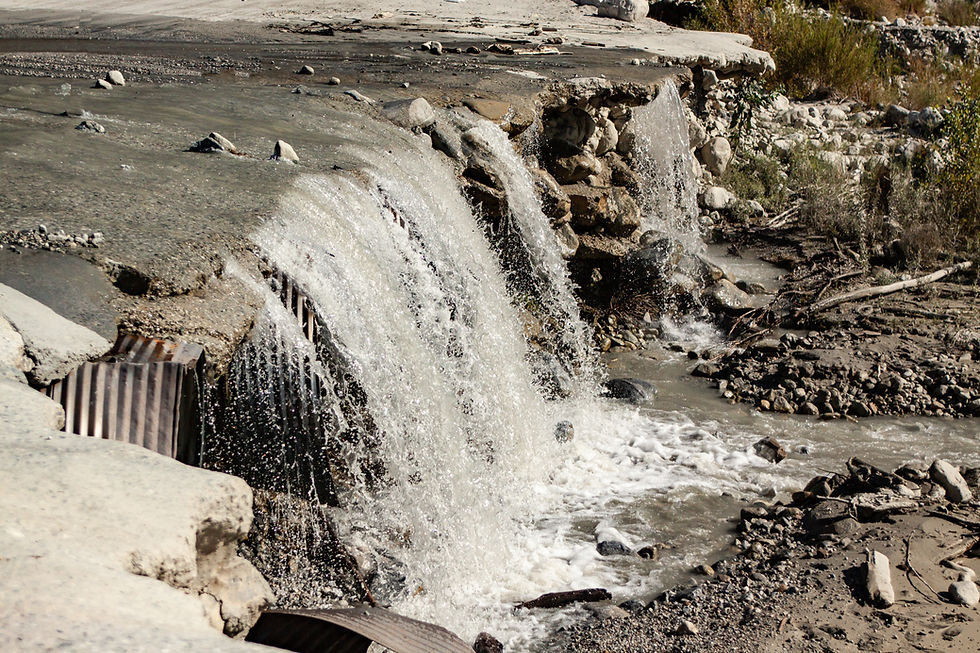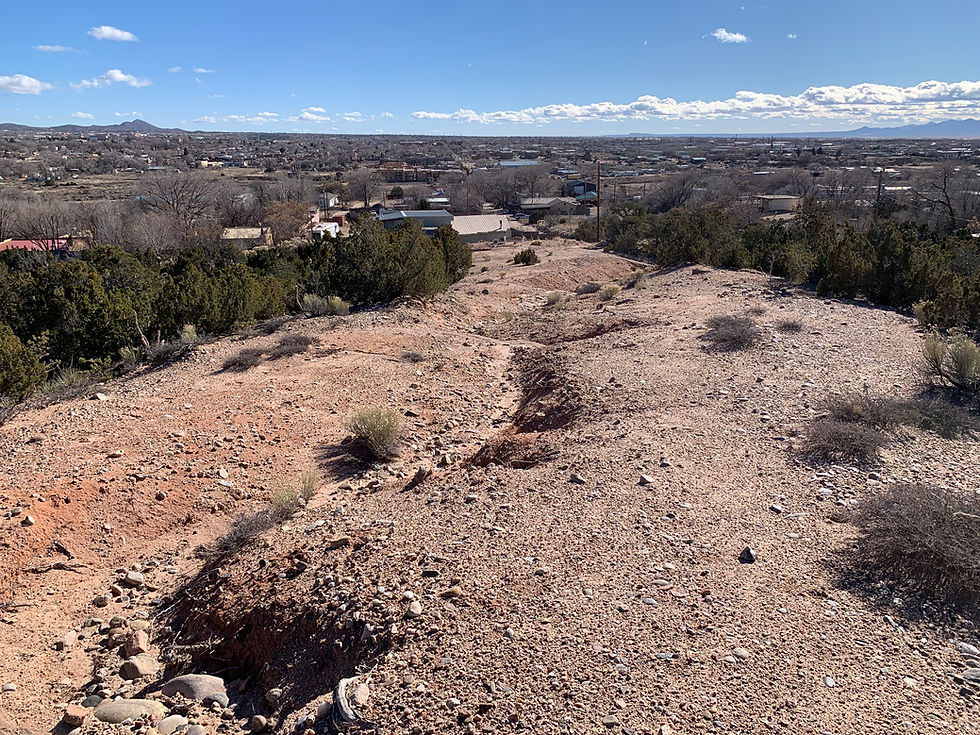
Rain Gardens
Rain gardens are an attractive green solution to reduce stormwater pollution and improve overall water quality. Rain gardens are a shallow depression designed to capture stormwater runoff and promote the natural filtration processes. These gardens utilize a variety of native plants, grasses and flowers, which improve aesthetics and provide a habitat for various types of wildlife. They can also be called rainwater harvesting basins, catchment basins, or infiltration basins. The use of geotextile or weed fabric should never be used in a rain garden, as it reduces water and air flow to plant roots and minimizes the amount of water that can soak into the ground. Rain gardens should be located at least 10 feet from the foundation of your home or other structures.

Bioswales/Mini-Swales
A bioswale is a shallow, linear, earthen channel that redirects water away from your home to where you want it to go, such as a rain garden or infiltration basin, slowing it down, and treating stormwater along the way. Swales collect rainwater directly from gutters, downspouts, canales, or redirect overflow from a cistern or rain barrel. Swales can be lined with wood mulch if there is very little flow in the swale, otherwise organic mulches tend to float away. Most often a swale should be lined (but not filled) with large cobble rock mulch to reduce erosion from flowing water. A bioswale should also have vegetation planted within it such as native grasses, wildflowers, or small shrubs. The use of geotextile or weed fabric should never be used in a bioswale, as it reduces water and air flow to plant roots and minimized the amount of water that can soak into the ground.

Rain Barrels/Cisterns
Rain barrels or cisterns are used to harvest stormwater from a roof and hold it for later use such as irrigation of gardens, trees, or indoor plants. Collecting roof runoff in rain barrels reduces the amount of stormwater that flows from your property, which helps to prevent erosion and stormwater pollution. This is a great strategy to use particularly in areas where you have a downspout or canale that flows to a driveway or other impermeable surface, or where you don’t have the space for a bioswale or basin because it would be too close to a structure like a property wall or your home.
The City of Santa Fe also offers a Rain Water Catchment rebate opportunity!

UNCONTROLLED STORMWATER CAN LEAD TO EROSION
As stormwater runoff moves across your property, from impervious surfaces and unvegetated areas, it can concentrate and cause erosion. As erosion increases from stormwater, more soil is dislodged and transported off of your property. Erosion and sedimentation can lead to significant property damage, as well as negatively affecting the city’s downstream drainage systems, roadways, waterways, and more.
.jpeg)

STORMWATER RUNOFF CARRIES POLLUTION INTO OUR WATER
Stormwater runoff can pick up sediment, fertilizers, automotive and household chemicals, pesticides, debris, pet waste, and other pollutants as it runs through your property, and travels untreated to our arroyos and into the Santa Fe River. Polluted waterways impact our drinking water supply, and reduce recreation opportunities and wildlife habitat.

UNCONTROLLED STORMWATER CAN LEAD TO FLOODING
Rainwater that falls in cities usually lands on impervious surfaces such as streets, parking lots, and rooftops. As Santa Fe continues to grow, more impervious surfaces are added and the amount of stormwater runoff increases. The stormwater runoff from these surfaces can be large enough to cause significant flooding, which can damage property or make travel difficult without proper stormwater management.

STORMWATER MANAGEMENT
IN THE HIGH DESERT
Stormwater runoff is a leading source of surface water pollution. As rain and snowmelt flows to the storm drain system, it pours over land, rooftops, yards, driveways, parking lots, and streets, picking up pollutants such as sediment, oils, trash, and pet waste. This stormwater runoff flows directly into our arroyos and eventually into the Santa Fe River untreated, which can significantly degrade water quality, thereby discouraging recreational use of our waterways, contaminating our drinking water supply, and damaging habitat for fish, aquatic organisms, and other wildlife.
While the City of Santa Fe is working to reduce pollutants flowing into our waterways, private property owners play a critical role in the success of this effort. Most property owners don’t know they are legally responsible for managing the terrain and stabilizing the soil within their property to protect against erosion and damage to any watercourses. Homeowners can receive a violation and fine for sediment transported off their property or damage that results from a debris clogged watercourse on their property.
While the City of Santa Fe is working to reduce pollutants flowing into our waterways, private property owners play a critical role in the success of this effort. Most property owners don’t know they are legally responsible for managing the terrain and stabilizing the soil within their property to protect against erosion and damage to any watercourses. Homeowners can receive a violation and fine for sediment transported off their property or damage that results from a debris clogged watercourse on their property.

![2023 City of Santa Fe Logo - Stacked [White].png](https://static.wixstatic.com/media/18db8f_bf91d6c119a644dbb825ddb754233c93~mv2.png/v1/fill/w_600,h_600,al_c,q_85,enc_avif,quality_auto/2023%20City%20of%20Santa%20Fe%20Logo%20-%20Stacked%20%5BWhite%5D.png)
Stormwater management
Santa Fe

STORMWATER CHALLENGES

Additional information and resources can also be found on the City of Santa Fe’s River and Watershed page, using the Santa Fe Watershed story map, and in the City’s Stormwater Utility Service Charge Ordinance.

Are you thinking of planting trees on your property? Save Water Santa Fe has recently published a guide to planting trees that thrive in the unique climate of Santa Fe. Using this guide, you can ensure that the trees you pick for your home or business are a good fit for the Santa Fe climate, utilize water appropriately, and contribute to the city’s urban canopy.

REQUEST AN ASSESSMENT
Please reach out to learn more about requesting a stormwater management assessment for your property by filling out the form below.
Your Stormwater Runoff Doesn't affect only you!
Allowing sediment to leave your property impacts roadways, clogs culverts, and can cause major flooding to your neighbors downstream. Not only that, but uncontrolled stormwater can also carry pollution into our rivers and streams and into our food and water supply!
Did you know?
You can be fined for not properly controlling erosion from your property
As a property owner, you are legally responsible for managing the terrain and stabilizing the soil within your property to protect against erosion and degradation of the watercourse. You can receive a violation for not controlling erosion and ensuring the watercourse within your property is free of sediment and debris. (13-2.4, 13-2.9, 13-2.17 SFCC 1987)
WHAT TOOLS CAN YOU USE?
The following section provides an overview of actions or best practices you can use to manage stormwater and minimize erosion and sediment issues at your home and property.


Permeable Pavers/Driveways
Permeable pavers, which can be used for roadways, driveways, or walkways, are concrete or brick pavers with intermittent gaps that allows rainwater to seep back into the ground, reducing the amount of stormwater runoff created as a result. They also help to hold soil in place in areas of high foot or vehicle traffic, helping to reduce erosion and sediment flows.

Infiltration Basins
Infiltration basins are vegetated depressions designed to store stormwater runoff on the surface and infiltrate it gradually into the ground. They are generally larger than a rain garden but function in the same manner. Organic wood mulch (3-inch depth) should be used surrounding plants. Do not use geotextile or weed fabric in an infiltration basin, as it reduces water and air flow to plant roots and minimizes the amount of water that can soak into the ground. Infiltration basins should be located greater than 10 feet from the foundation of your home or other structures.

Rain Gutters, Canales, and Downspouts
Rain Gutters, canales, and downspouts are used to direct stormwater from your roof to a rain barrel/cistern or the ground, protecting your home from water damage. These systems can be used with rain barrels to harvest rainwater for personal use or to direct stormwater into rain gardens and bioswales. Look for a canale catcher to help redirect the flow from a canale into a rain barrel or bioswale.

Rock Check Dams
Check dams are rock structures in a conveyance feature (such as a bioswale or bar ditch) designed to slow water, reduce erosion, and increase infiltration.

Bar Ditch
A bar ditch (sometimes referred to as a borrow ditch) is a roadside channel dug for drainage purposes. Roadside ditches function to keep stormwater and sediment off the roadways.

Driveway Culverts
A culvert is a metal, concrete, or plastic structure that conveys stormwater underneath a driveway, road, or other obstruction.

Track Pad
A track pad is used to provide a stable entrance and exit from a driveway, and to reduce the amount of mud, debris and sediment traveling in and out of a residential property.

Covered Trash Bins
When trash bins are left open and exposed to precipitation, rainwater can wash contaminants out of a waste container and into our waterways. Covers also prevents wind from picking up light objects from the bins and dispersing them. Providing a cover for a waste container is the easiest way to prevent the release of trash and potentially contaminated stormwater from your trash bins. It’s also important to remember to properly dispose of all yard waste, and to never dispose of any waste in an arroyo, stream, or river.

Clean Up Pet Waste
When it rains, pet waste that has been left on the ground washes into storm drains and washes into our arroyos and rivers. The waste, along with the other harmful bacteria, reduce our water quality and can lead to designations by the EPA as an impaired waterways.
Thinking about building an addition, a shed, a garage or a driveway?
Check out the Santa Fe Code Section 14-8.2(E) for minimum stormwater management standards for building permits for minor development!